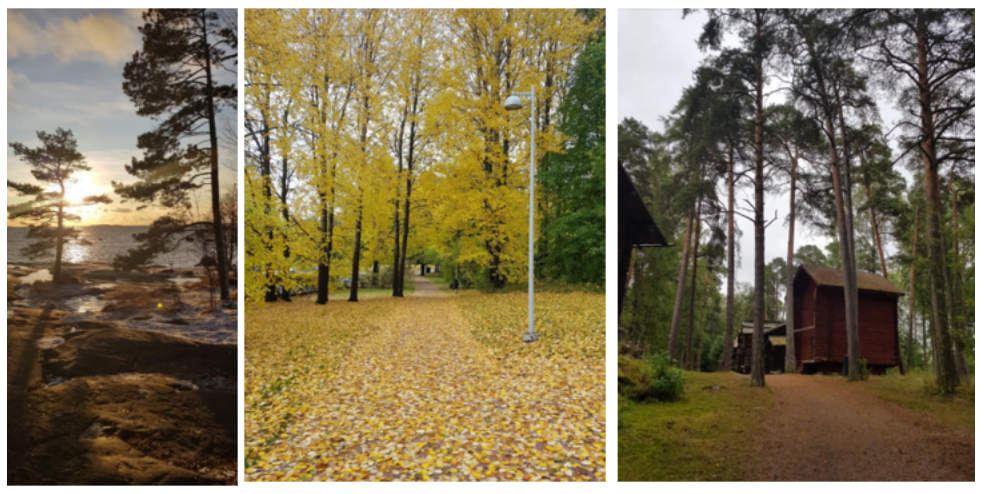I never imagined that I would find myself living in Helsinki, Finland but after almost eight months living here, I am now a full supporter and advocate for Finland. On the 5th of June, I packed my bags and boarded my first ever, one-way flight, to the land of Santa Claus and Saunas. I was lucky enough to be greeted by a family friend at the airport and was taken directly to an official shop to have my Finnish identification photo taken. It was summer and I remember being surprised that it was significantly warmer and sunnier than London. For some reason I thought Finland was permanently snowed in and this is a stereotype I have to now fight off myself. We then went to the family home and I was greeted by my housemate to be, a charming elderly Swedish man who proceeded to welcome me with a glass of Aquavit and baked salmon – when in Rome? This set the stage for what I imagined it was going to be like for the next 4 years!
I spent the first few days exploring Helsinki by running around the islands in the bay, this also helped me deal with the stress of not knowing anyone. Luckily, I joined a very friendly lab and was invited to join a midsummer social on Pihlajasaarito to meet other University of Helsinki students from Finland and abroad. Apparently, moving in during the summer was good idea as everyone is in a considerably better mood, the nights are long and the Finns are more social than usual. At the same time, during this time of year, a mass migration of Finns to the forest (summer houses in the countryside) for berry picking and traditional sauna occurs and Helsinki becomes populated only by tourists and people like me!
Having now met many people here, everyone seems to ask the question “Why Helsinki!?” as if I’m a lunatic. I always wanted to do my PhD outside the UK, learn a new language and get outside my comfort zone. I was thinking about applying to Germany but thought it was too classical of a scientific career pathway. The opportunity presented by STACCATO (European Industrial Doctorates programme), specifically TILT Biotherapeutics Ltd was also perfect, as it combined academia, industry and the chance to carry out a secondment in another country. STACCATO also aims to connect and support early-stage researchers throughout Europe and so I am glad to share this journey with other students who share similar aspirations and interests for life sciences entrepreneurship.
With this, I now feel settled and even have Helsinki-withdrawal when I go back to London for too long. However, there are a few things that have taken some time to get used to, such as being fully nude in the sauna with colleagues or the ‘awkward silence’ that is typical of lunch hour, something the Finns call ‘ruokarauha’ (food peace). Nevertheless, I look forward to learning more about Finnish culture and I see a lot of potential from a relatively unknown country leading the world in terms of social welfare, education and equality.

What’s all the hype around oncolytic viruses?
But back to the point. Why I moved to this Nordic country– to contribute to the advancement of immunotherapy, specifically oncolytic viruses. There is a lot of hype around this technology due to its potential as a cancer therapy, particularly in patients unresponsive to immune checkpoint inhibitors (antibodies that prevent useful immune cells from becoming exhausted). This is because they offer a versatile tool for killing cancer, in that they selectively replicate in tumour cells and can express transgenes that augment cytotoxicity and alter the tumour microenvironment to enhance immune-mediated tumour killing both at primary and secondary sites of disease.
The lytic activity of oncolytic viruses comes with the natural life cycle of the virus, after several rounds of viral replication; the cell bursts resulting in the release of new virions and the infection of the surrounding cells. The cell lysis releases tumour-specific antigens that trigger both the innate and adaptive immune system, this process is described as altering the tumour microenvironment from immunologically cold to hot. This status change is associated with an improved therapeutic response and more durable remission in patients. There are almost endless amounts of possible modifications to the various families of viruses. Consequently, modified oncolytic viruses are attractive for use in combination with other systemically delivered therapies and agents as a treatment regime is tailorable to the malignant phenotype. This offers the benefit of providing resolution to the large, underserved population of patients who fail to respond to existing therapies.
As an example, I recently enjoyed reading about the use of a modified Vaccinia virus engineered to produce Leptin, a metabolic modifier usually associated with appetite. Metabolic insufficiency is a significant barrier for sustained antitumor immunity and is a typical profile of immune cells found in the tumour microenvironment. This is largely a result of the highly glycolytic profile of the tumour– also known as the Warburg effect. The paper showed that by using this leptin expressing virus, they were able to improve the metabolic capacity of T- cells and therefore put them back in the driver’s seat. This paper is one of a few that have taken a different approach to the traditional virus design of using cytokines or costimulatory molecules. I hope that this will trigger a wave of new generation of viruses that target the metabolic hallmark to improve antitumor efficacy.
TILT-123 for head and neck squamous carcinoma
But what exactly am I doing? I am funded by a Marie-Curie early-stage researcher EU training grant, designed with the goal of using state-of-the-art single cell sequencing technologies, to deepen our understanding of the therapeutic mechanisms behind oncolytic viruses and investigate ways to improve production. TILT Biotherapeutics Ltd is a spin out from the University of Helsinki, with a highly promising patented oncolytic adenovirus engineered to enhance T cell therapies – TILT-123.
The most significant modifications to TILT-123, includes the ability of the virus to produce two powerful cytokines, IL-2 and TNFa, which enhance T- cell proliferation and exert direct cytotoxicity to the tumour and associated vasculature respectively. This combined with the lytic life cycle of the virus, makes for a power weapon of mass destruction. The efficacy of TILT-123 has already been validated in other types of cancer using animal models, with the virus reaching up to a 100 % cure rate in combination with tumour infiltrating lymphocytes (local T- cells familiar with the tumour from the patient itself). Subsequently TILT Biotherapeutics Ltd will start a first-stage clinical trial this year for melanoma in combination with adoptive transfer of tumour infiltrating lymphocyte, so watch this space!
My first task will be to extend TILT123’s portfolio of different cancer types, starting with squamous cell carcinomas of the head and neck in combination with checkpoint inhibitors. I will validate its therapeutic efficacy using a syngeneic murine and Syrian Hamster model. The former provides us with a detailed insight into immunological mechanisms, while Syrian hamsters, as a semipermissive model, provides additional insight on how the lytic properties of TILT-123 contributes to the overall efficacy and immunological landscape. Additionally, I will look into optimising the manufacturing of this immunotherapy, by identifying genetic profiles of producer cells associated with an increased yield and vector quality. Some initial challenges have included developing the Syrian Hamster model. Since this is not a commonly used model, the availability of many tools required for experimental procedures and characterisation is limited.

Altogether, Finland has been a fantastic experience, both, as a culture shock but also the skills I have already learned as a scientific researcher. One of the most important traits for Finns is something called “sisu”, a concept described as stoic determination with no equivalent in English. Over the next four years, I hope to find my sisu and use this to work together with a bunch of eager scientists to contribute to the field and improve the world.
Posted by James.